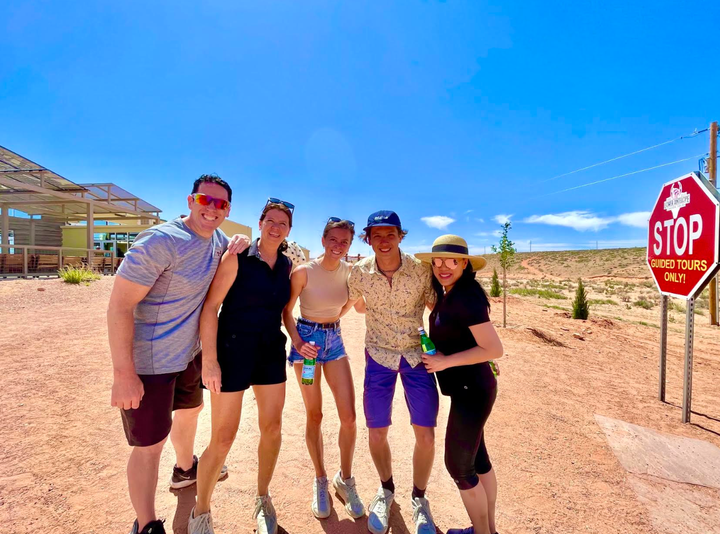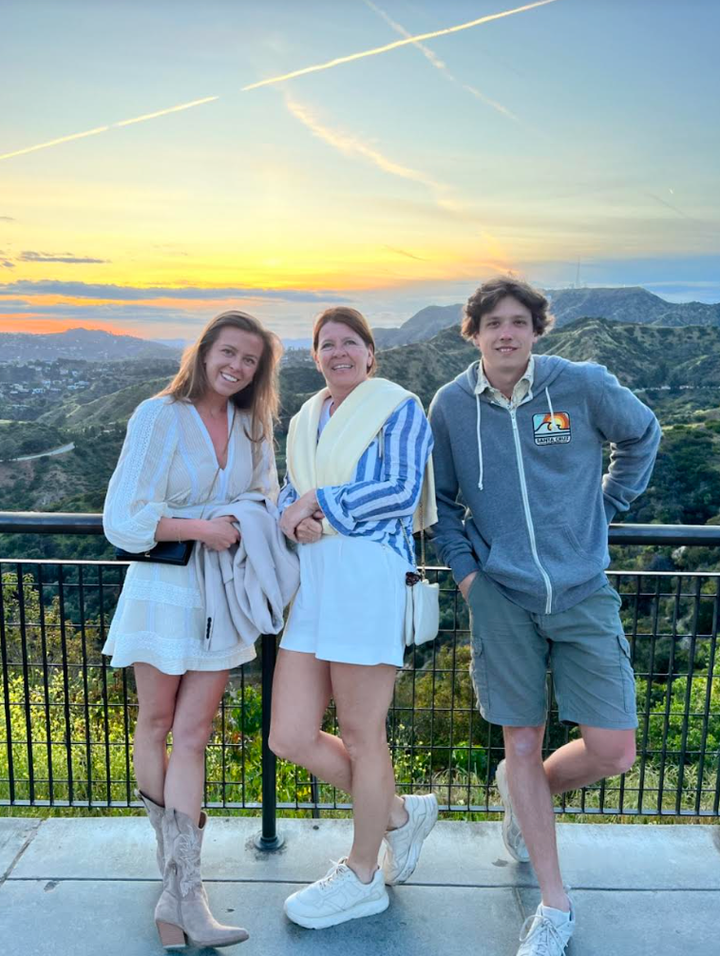One evening last year while my husband and I were on vacation in Arizona, we sat down in a Mexican restaurant next to a middle-aged woman and her two college-aged kids. They nodded a friendly hello at us, and then returned to playing a card game while they waited for their dinner to arrive.
I was impressed that there weren’t any cellphones on their table. Just as I was thinking we should try the same thing with our own kids, the woman leaned over and, with a slight accent, made small talk with us about the restaurant’s chips and salsa.
The conversation quickly expanded to weightier topics. She told us they were currently visiting from the Netherlands and spending several days touring the western half of the United States. She regaled us with stories about all the countries they’d visited. Her children frequently chimed in to share memories of their trips and how much they loved the people and cultures they’d encountered. It delighted me to know that these two young adults had received the kind of active, hands-on education that only comes with traveling.
I enjoyed their stories so much that I secretly wanted to push our tables together and share our meals. Several times I thought of asking for their names and contact information, but I was deathly shy and worried that they might think it was a strange request. When it was time to leave, I wanted to scream — it felt so wrong to say goodbye without having a way to stay in touch, but I just couldn’t bring myself to ask.
The next day, my husband and I finished our getaway with a tour at Lower Antelope Canyon. Afterward, as we were walking toward the parking lot, I saw the Dutch family approaching the entrance. Ecstatic, I waved them down. The mom and I shouted, jumped and hugged. “What a small world!” we both repeated. My husband and I took turns hugging her children, and none of us could stop smiling. The mother handed me a bottle of carbonated water and reminded me to stay hydrated in the desert sun. Then she said they had to run because they were late for their tour. Again, I was dying to ask for her name and contact info, but instead I said, “Can we get a picture together?”

As we posed for the photo, a voice in my head hollered, “Get! Their! Info!” But ... I didn’t. I felt awkward and, despite how warm and lovely the family had been to us, I worried that they’d think it was weird for me to want to keep in touch after barely knowing them for more than a few — however wonderful — hours. My husband and I were about to drive 355 miles back home, and they would be returning to the Netherlands soon. This goodbye was forever.
Days later, I was still thinking about the family. Even though the mom never said they lived in Amsterdam, I added that city to the world clock on my phone, so I always knew what time it was in the Netherlands and I could imagine what they might be doing. I couldn’t get them off my mind and, more than ever, I regretted not getting their info.
I wished there was a way to find them. But how? How would I go about locating these three random individuals in a sea of people without any idea what their names were or what city they lived in?
Then it hit me: sea! I remembered how, in the movie “Finding Nemo,” an Australian dentist catches Nemo, a clownfish, and keeps him in an aquarium at his clinic. Nemo’s father, Marlin, tries to find his son, but it’s nearly impossible — the ocean is vast, and the only thing he knows is that Nemo is somewhere in Sydney. With the help of a group of sea creatures, Marlin discovers his son’s whereabouts. Many of the sea creatures don’t know Nemo or Marlin — they don’t even know one another — but these strangers form a web of connections that leads to Nemo’s eventual reunion with his dad. I wondered if the same strategy might reunite me with my Dutch friends.
I immediately posted our group photo on Facebook and invited my friends and connections to form a digital human chain to conduct a “Finding Nemo” style search across two continents. Within hours, my post was shared over 85 times. Messages poured in from around the world to wish me luck and ask for updates, but no one knew my friends. I was aware that my chances of finding the Dutch family were slim, but I held out hope that it would happen. Four days later, a message from a stranger showed up in my inbox with these seven glorious words: “I know the people in the picture!”
I almost fainted!
The stranger, Ms. Beaumont, was the head of the primary school that the kids had attended years earlier. Her message read: “I couldn’t sleep last night and was scrolling Facebook for a while. ... I saw the [post] from my friend, Ineke, [who shared your] photo. I couldn’t believe my eyes. ... Sleeping was no option anymore. I dug into the old school archives and found [Anne and Bas].”
Anne and Bas were just kids when they attended Ms. Beaumont’s school. In my picture, they’re young adults. How did she recognise them after all these years?
“I recognised [the] mother! I didn’t recognise Anne and Bas,” Ms. Beaumont replied. Years later, she still remembered the brilliant smile of their mother, Ingrid. After seeing my photo, Ms. Beaumont pored over a decade’s worth of yearbooks, combed through students’ photos, and found my young friends’ names. Then she tracked down their social media handles and sent me the links. Imagine anyone going through that much work to help someone else — and in my case, a complete stranger! It’s hard for me to comprehend that level of generosity.
I couldn’t believe that my Disney-inspired scheme had worked! Thanks to my friends and complete strangers, I found the Dutch family with nothing more than a picture.
I reached out to Ingrid immediately. She was equally thrilled that I’d found her and especially amused by the “Finding Nemo” method I’d used to make it happen.

We continued to send texts and photos to each other, and I felt like I’d reunited with a long-lost childhood friend. I learned that Ingrid is a business liaison and advocate for deaf employees, and that she negotiates job benefits on their behalf. As a tech-savvy tourist, she introduced me to several travel apps I’d never heard of before. Overjoyed to be re-connected, we proposed a plan to meet up when we visit each other’s countries next year.
Finding Ingrid was unbelievable, but it only happened because a group of generous people — many of them strangers — saw and shared my Facebook post. That graciousness blossomed into unexpected friendships — with Ingrid, of course, but with others as well.
Ms. Beaumont taught me about how the Dutch educational system works. I was impressed with the outdoor classrooms, green playground and movement paths at her school, all of which help children cultivate a love for nature and teach them to grow vegetables and flowers.
Ineke, the altruistic stranger who shared my post with her friends in the Netherlands, which allowed it to eventually reach Ms. Beaumont, told me about the Dutch tradition of “flying the flag” — high school students hanging their backpacks on their home flagpoles to signify that they’ve passed their exams and graduated.
I was moved by all these strangers’ willingness to welcome me into their social circle and share their fascinating culture with me. I was witnessing the best of humanity — a world lifting up one soul, benevolence beyond nationalities, kindness without borders. It feels especially meaningful in the aftermath of the COVID-19 quarantine and isolation that we all struggled through. But beyond that, any time people are able to make connections in modern society, where everyone is busy and many of us are closed off from meeting new people, it feels like a miracle.
Perhaps even more miraculous is that all of this happened online — a place known for cyberbullying and scamming, and where dialogues often lead to personal attacks and heated disputes. But we have the power to counter that negativity by choosing kindness.
I’m deeply grateful that hundreds of people deposited in the goodwill bank and created a real-life “Finding Nemo” miracle for me. This experience not only brought me precious new friends, but also encouraged me to change the way I live and to find new ways to engage with the world around me.
In the future, if I meet someone — in real life or virtually — I won’t be as shy as I was in Arizona. I’m committed to being open to opportunities. There’s so much to learn, and we never know who we’ll meet or what we’ll encounter on any given day in any given place. The less closed-off we can be, the more chances we have to experience something new — life-changing, even. And if I happen to come across a call for help like the one I sent out, I’ll do whatever I can to make that connection happen. Who knows? I might be the one who can assist a stranger in locating a lost friend.
Allison Hong Merrill is a Taiwanese immigrant and a love-aholic whose motto is “Be obsessed with love and kindness.” She’s the author of “Ninety-Nine Fire Hoops: A Memoir” and is writing its prequel, a hundred-year Taiwanese saga with family secrets that ends in her unexpected American dream. Sign up for her short monthly email at www.AllisonHongMerrill.com.